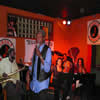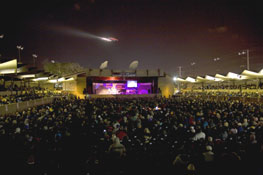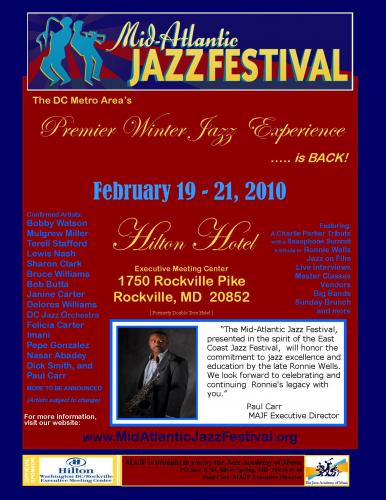The contributor of this piece is jazz activist Ron Washington. Besides being a stalwart jazz diehard and tireless observer of the scene, he is proprietor of Ron "Slim" Washington Productions, which provides jazz and other music for festivals, clubs and restaurants.

Ron "Slim" Washington (with mic) onstage at one of his jazz productions
How Can a “Music of the Spirit†Die?
Jazz is dead! Here we go again; i.e. the recent Wall Street Journal article by Terry Teachout declaring that no one is listening to jazz and featuring a prominent cartoon of a “black Jazz musician†being wheeled out on a cart speaks volumes to a continued bourgeois, arrogant Eurocentric lack of understanding of jazz.
Mr. Treachout’s methodology is the classic case of someone going out to investigate the flowers, but never getting off the horse to “smell the flowers.†Hence the article is so “lightweight†I had to keep a paper-weight on it to keep it from elevating and floating away on its own. Put another way, as Amiri Baraka in his latest book “Digging†would say, “The lack of knowledge about
Treachout uses a number of useless (without context!) numbers from a National Endowment of the Arts survey to conclude that only those with their head in the sand cannot see a larger picture of “lack of mass support for jazz†leading to its demise. There were fewer people attending a jazz concert; the audience is (graying) growing older; older people are less likely to attend jazz performances today than yesterday; and the audience among college educated adults is also shrinking. On the surface, this kind of approach can scare or misinform a great many people into following the ever present “jazz is dead†attacks upon the music. This kind of approach is not the approach of someone who wants to help jazz survive, but one that serves to drive people away from exploring and learning about jazz.
How about we come at the non arguable “less than healthy’ state of jazz another way? Once again we call on
From the great work “Blues People,†to his other book, “Black Music,†and the latest contribution from the peoples’ critic, “Digging,†there is one thing that stands out. Amiri Baraka insists that the music, from blues to jazz, is a creation and reflection of the struggles of the Afro-American people. The music is an expression of a people’s culture and cannot be separated from such. Jazz, Afro-American in origin, universal in content and expression, is nonetheless tied to a people, expressing their greatest fears and joys, hopes for the future and repository of the past, that it can said, “the music is the people.†Hence the music can never die, because the people live. Bill Cosby is quoted in Digging as saying, “There’s a wonderful story I like to tell. It’s the end of the world…gray, blowing, turbulent… and there is this tombstone that says, ‘Jazz: It Broke Even!’ The music has its high and lows, but it can never die.â€
Art is a reflection of a people’s culture. As Baraka says, “Whether African Song, Work Song, Spiritual, Hollers, Blues, Jazz, Gospel, etc., no matter the genre, the ideas contained in Afro-American art, in the main, oppose slavery and desire freedom.†(Digging). For jazz to die, the entire history and Afro-American people would have to die. This is the content that an interloper like Treachout cannot understand.
But since jazz is what the great trumpet player Ahmed Abdullah calls, “the music of the spirit,†it can never die. While the WSJ declares jazz dead, refuses to get off the horse and smell the flowers, the music continues to thrive and fight for its life, for its expression. In
Jazz is not popular culture. To compare and demand that Jazz be equated with the lowest common denominator cultural expression, packaged for the most extreme exploitation by monopoly capitalism is to have no understanding of the music. By its very nature it is “rebel†music. Treachout complains that it is not the music of the masses, of the youth, as determined by corporate measuring sticks. Well of course. I like hip-hop but I’m not going to any concerts. That’s youth music. Not particularly challenging.
When we say jazz is “a music of the spirit,†sitting in on a jazz program has the possibility of elevating the listener to heights never experienced by a poplar culture event. For many it is a shared communal experience, as witnessed by the common clapping in appreciation of a musical interlude, or the strictly individual experience of the music. Some can appreciate the full recipe of musical virtuosity on display, some may connect deeply in an emotional way with the music, some relate to the democratic display of the skills of the musicians, and some may not have liked the particular performance.

Amiri Baraka’s latest volume on jazz Digging
Ron Washington, September 10, 2009



